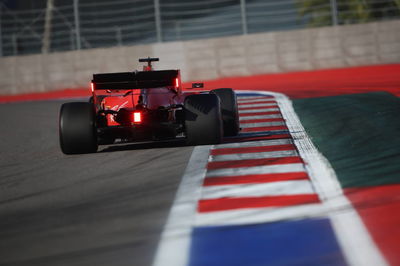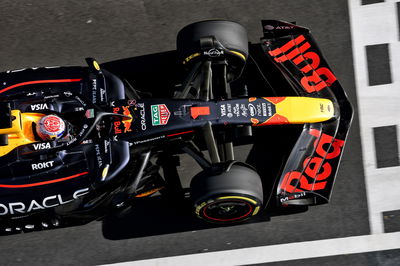F1 Race Analysis: Was Vettel right to ignore Ferrari’s team orders?
The narrative of the brewing rivalry between Charles Leclerc and Sebastian Vettel at Ferrari had been predicted from the moment it was announced they would be teammates for the 2019 season.
But in Russia on Sunday, we saw tensions hit a new high as Ferrari’s bid to employ team orders backfired, contributing to the team’s loss to Mercedes as it snatched defeat from the jaws of victory.
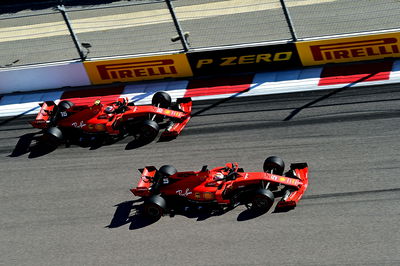
The narrative of the brewing rivalry between Charles Leclerc and Sebastian Vettel at Ferrari had been predicted from the moment it was announced they would be teammates for the 2019 season.
But in Russia on Sunday, we saw tensions hit a new high as Ferrari’s bid to employ team orders backfired, contributing to the team’s loss to Mercedes as it snatched defeat from the jaws of victory.
While Leclerc had managed to bag his fourth straight pole position in qualifying on Saturday, Vettel had again struggled to match his teammate’s pace, taking P3 on the grid and continuing a concerning trend of losing out to Lewis Hamilton despite a perceived car advantage in recent races.
Just as it did in Singapore – to good effect, it must be noted – Ferrari quickly worked on a plan to get its cars one-two, identifying the long run to Turn 2 as a good opportunity to get the jump on Hamilton and take control of the race.
So an agreement was struck. Assuming the getaway from the grid went smoothly, Leclerc would give Vettel a slipstream to allow him to get ahead of Hamilton. Were Vettel to get enough of a tow to challenge for the lead, Leclerc would not put up any resistance, knowing that later in the race they would swap the cars back around, returning the favour he gave via the slipstream on the opening lap.
That was the plan. As we all know, it did not unfold that way.
Vettel did get a good start, using the tow from Leclerc to pass Hamilton and move into the lead, with his teammate putting up no fight at all. The race was quickly put behind the Safety Car after an incident further back, during which Leclerc was informed that the swap would go ahead as planned.
Vettel kept pushing, though. He was asked at least twice to move aside for Leclerc. The first time, he told the team that it was too early, fearing Hamilton was too close. The second, he wanted Leclerc to get closer. At no point did he ease his pace to give his teammate the opportunity to catch up, causing the gap to get bigger and bigger.
“It was fair enough to say at that stage in the race that, maybe Charles was not close enough, and we would have lost some time on track,” said Ferrari team boss Mattia Binotto after the race. “Later on, Seb was quite fast and gained some track advantage on Charles. So we knew that we could decide to do [the swap] later on.”
This prompted Ferrari to change tack. Vettel was given the go-ahead to keep pushing and to build a gap, extending his advantage over Leclerc to more than four seconds by the time the first pit stops came around.
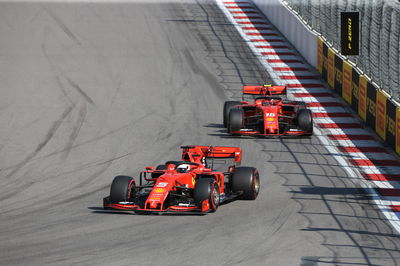
Leclerc’s tyres had begun to fade towards the end of the first stint, allowing Hamilton – running on Mediums – to close up behind. The gap between the pair dropped from 3.3 seconds to less than 2.5s in the five laps before Leclerc pitted, making the decision to bring him in first the correct one had there been a fear of Hamilton getting the undercut. But the fact Hamilton was running on Mediums – thus making it a bit too early to change to Softs – and that he had been told to run to “target plus 15” five laps earlier should have been enough to inform Ferrari that this was not a threat.
Was the timing of Leclerc’s stop intended to give him the lead over Vettel? Binotto claimed it was not after the race. “The undercut was not for the reason for giving back the position to Charles,” he said. “Charles stopped because he had worn tyres. His left-rear was starting to be worn, so it was the right moment for him to pit.”
Soon after Leclerc pitted, Vettel piped up on team radio, saying that his rear tyres were “falling off”. His pace reflected this, his times dipping from mid-to-low 1m38s to high-1m38s, allowing Hamilton to cut the gap to five seconds, having been more than seven adrift at one point.
Ferrari did not use the same approach it had with Leclerc, though, keeping Vettel out. “We knew that if we had stopped both our cars there, we would have been vulnerable on Safety Cars by giving the lead to Hamilton,” said Binotto. “So we tried to stay out as much as we could with Seb, simply to protect in case of Safety Cars later in the race.”
“As much as we could” amounted to a whole four laps longer than Leclerc – just enough for the Monegasque to get the undercut and reclaim the net lead of the race.
The irony rung loud just minutes later when Vettel crawled to a halt due to a suspected MGU-K failure on his Ferrari power unit, parking up at the side of the track and triggering a Virtual Safety Car period that allowed Hamilton to pit and emerge ahead of Leclerc – the very thing Vettel’s long stint had been trying to prevent.
There was nothing untoward about where Vettel parked up his car, despite what the Twitter conspiracy theorists may say. It was unsafe, with the FIA confirming after the race that the electrical light on top of his car was on, meaning the car was still ‘live’. An immediate stoppage by Vettel and the subsequent VSC was the correct course of action.
Ferrari certainly got unlucky with the timing, but didn’t help itself by not reacting immediately with Leclerc in the pits. Instead of bringing him straight in for a set of Softs to mirror Hamilton’s strategy, Ferrari waited an additional lap before making the call – by which point, Valtteri Bottas had also pitted and made the same jump as Hamilton. It left Leclerc third on-track, which is where he would finish.
Something was clearly up in Ferrari’s plan, as much as all parties may claim after the race they were satisfied with the explanations given and that no-one broke protocol. The fact is clear: Vettel did defy the call to let Leclerc past.
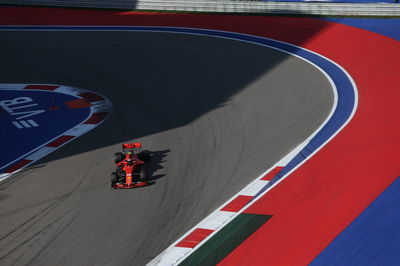
But was he justified in doing so? His pace through the early part of the race was clearly better than that of Leclerc, who struggled to keep up with his teammate. Although Vettel wanted a bigger gap to Hamilton, the then-three second gap Leclerc had built would likely have been enough, assuming the position swap had come in the right place.
But would they have then both been under pressure if Leclerc wasn’t able to match his pace? Would Vettel have then been asking for them to swap back again?
There was definitely some rationale behind Vettel’s decision-making on Sunday. The agreement may have been in place, but as always in F1, there is a need to be pragmatic and reactive, especially when it comes to strategy. Ferrari had been too focused on getting the cars in P1 and P2 at the start instead of trusting its drivers to keep it clean and do the job themselves. It tried being too clever.
The power struggle at Ferrari is continuing to rumble on. And while everyone may be sticking to the party line tonight, next time – and there will be a next time - things may not be quite so cordial…
